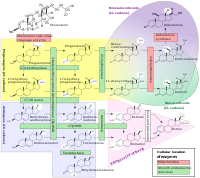Congenital Adrenal Hyperplasia Due To 11-Beta-Hydroxylase Deficiency

Congenital adrenal hyperplasia (CAH) due to 11-beta-hydroxylase deficiency is one of a group of disorders (collectively called congenital adrenal hyperplasia) that affect the adrenal glands. The adrenal glands are located on top of the kidneys and produce a variety of hormones that regulate many essential functions in the body. In people with CAH due to 11-beta-hydroxylase deficiency, the adrenal glands produce excess androgens, which are male sex hormones.
There are two types of CAH due to 11-beta-hydroxylase deficiency, the classic form and the non-classic form. The classic form is the more severe of the two types.
Females with the classic form of CAH due to 11-beta-hydroxylase deficiency have external genitalia that do not look clearly male or female (atypical genitalia). However, the internal reproductive organs develop normally. Males and females with the classic form of this condition have early development of their secondary sexual characteristics such as growth of facial and pubic hair, deepening of the voice, appearance of acne, and onset of a growth spurt. The early growth spurt can prevent growth later in adolescence and lead to short stature in adulthood. In addition, approximately two-thirds of individuals with the classic form of CAH due to 11-beta-hydroxylase deficiency have high blood pressure (hypertension). Hypertension typically develops within the first year of life.
Females with the non-classic form of CAH due to 11-beta-hydroxylase deficiency have normal female genitalia. As affected females get older, they may develop excessive body hair growth (hirsutism) and irregular menstruation. Males with the non-classic form of this condition do not typically have any signs or symptoms except for short stature. Hypertension is not a feature of the non-classic form of CAH due to 11-beta-hydroxylase deficiency.
Frequency
CAH due to 11-beta-hydroxylase deficiency accounts for 5 to 8 percent of all cases of congenital adrenal hyperplasia. It is estimated that CAH due to 11-beta-hydroxylase deficiency occurs in 1 in 100,000 to 200,000 newborns. This condition is more common in Moroccan Jews living in Israel, occurring in approximately 1 in 5,000 to 7,000 newborns. The classic form of CAH due to 11-beta-hydroxylase deficiency appears to be much more common than the non-classic form.
Causes
Mutations in the CYP11B1 gene cause CAH due to 11-beta-hydroxylase deficiency. The CYP11B1 gene provides instructions for making an enzyme called 11-beta-hydroxylase. This enzyme is found in the adrenal glands, where it helps produce hormones called cortisol and corticosterone. Cortisol has numerous functions, such as maintaining blood sugar levels, protecting the body from stress, and suppressing inflammation. Corticosterone gets converted to the hormone aldosterone, which helps control blood pressure by maintaining proper salt and fluid levels in the body.
CAH due to 11-beta-hydroxylase deficiency is caused by a shortage (deficiency) of the 11-beta-hydroxylase enzyme. When 11-beta-hydroxylase is lacking, precursors that are used to form cortisol and corticosterone build up in the adrenal glands and are converted to androgens. The excess production of androgens leads to abnormalities of sexual development, particularly in females with CAH due to 11-beta-hydroxylase deficiency. A buildup in the precursors used to form corticosterone increases salt retention, leading to hypertension in individuals with the classic form of CAH due to 11-beta-hydroxylase deficiency.
The amount of functional 11-beta-hydroxylase enzyme that an individual produces typically determines the extent of abnormal sexual development. Individuals with the classic form of the condition usually have CYP11B1 gene mutations that result in the production of an enzyme with low levels of function or no function at all. Individuals with the non-classic form of the condition typically have CYP11B1 gene mutations that lead to the production of an enzyme with moderately reduced function. The severity of the signs and symptoms of sexual development do not appear to be related to the severity of the hypertension.
Learn more about the gene associated with Congenital adrenal hyperplasia due to 11-beta-hydroxylase deficiency
Inheritance Pattern
This condition is inherited in an autosomal recessive pattern, which means both copies of the gene in each cell have mutations. The parents of an individual with an autosomal recessive condition each carry one copy of the mutated gene, but they typically do not show signs and symptoms of the condition.